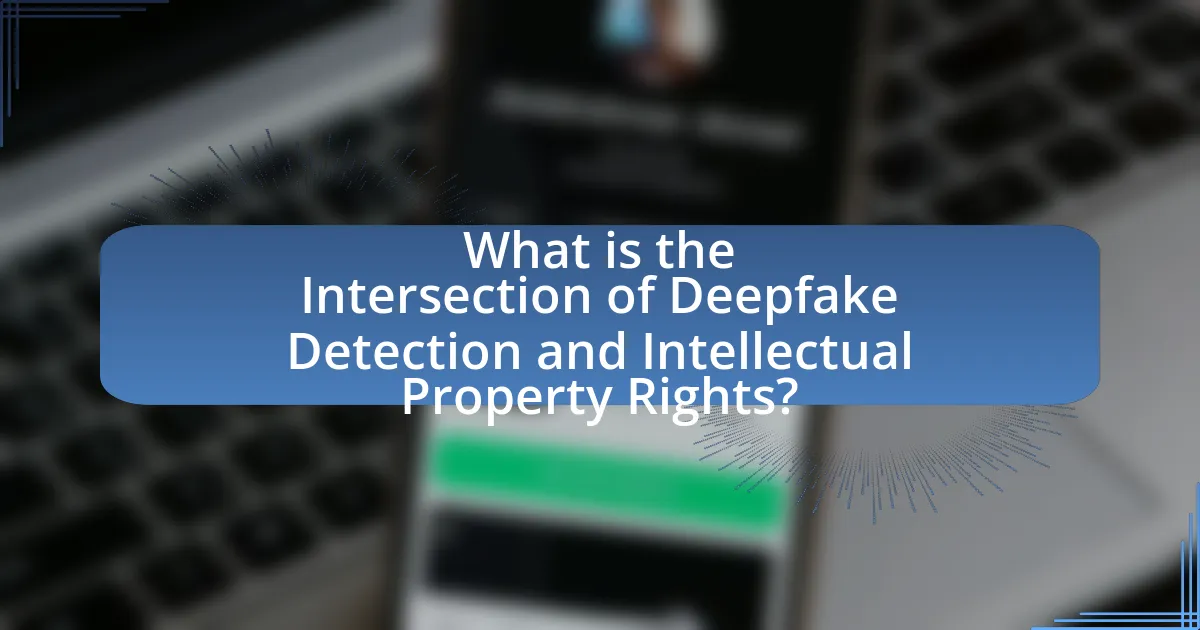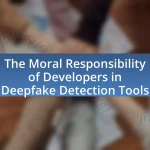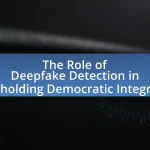The article examines the intersection of deepfake detection and intellectual property rights, focusing on the legal implications of deepfake technology concerning copyrighted materials and personal likenesses. It discusses how deepfakes challenge traditional intellectual property rights by creating unauthorized reproductions that can mislead audiences and infringe on creators’ rights. Key areas affected include copyright, trademark, and the right of publicity, with a particular emphasis on the need for effective detection technologies to combat misuse. The article also outlines existing legal frameworks, proposed regulations, and best practices for stakeholders to navigate the complexities introduced by deepfakes in the digital landscape.

What is the Intersection of Deepfake Detection and Intellectual Property Rights?
The intersection of deepfake detection and intellectual property rights involves the legal implications of using deepfake technology in relation to copyrighted materials and personal likenesses. Deepfake detection technologies aim to identify manipulated media that can infringe on an individual’s rights, including the unauthorized use of their image or voice, which is protected under intellectual property laws. For instance, the use of a celebrity’s likeness in a deepfake video without permission can violate their rights of publicity, which are designed to protect against unauthorized commercial exploitation. Additionally, as deepfake technology evolves, it raises concerns about the potential for copyright infringement when original content is altered and redistributed without consent, highlighting the need for robust detection methods to safeguard intellectual property rights.
How do deepfakes challenge traditional intellectual property rights?
Deepfakes challenge traditional intellectual property rights by creating unauthorized reproductions of individuals’ likenesses, voices, and performances, which can infringe on the rights of creators and performers. This technology allows for the manipulation of media in ways that can mislead audiences and undermine the original creator’s control over their work. For instance, deepfakes can be used to produce counterfeit videos that appear authentic, leading to potential violations of copyright and personality rights. Legal frameworks often struggle to keep pace with these advancements, as existing laws may not adequately address the complexities introduced by deepfake technology, resulting in ambiguity regarding ownership and consent.
What types of intellectual property are most affected by deepfakes?
The types of intellectual property most affected by deepfakes include copyright, trademark, and right of publicity. Copyright is impacted as deepfakes can use copyrighted materials, such as images or videos, without permission, leading to potential infringement. Trademark rights are affected when deepfakes misrepresent brands or create confusion in the marketplace, potentially harming brand reputation. The right of publicity is compromised when individuals’ likenesses are manipulated in deepfakes without consent, violating their personal rights. These impacts highlight the legal challenges posed by deepfakes in protecting intellectual property.
How do deepfakes infringe on copyright and trademark protections?
Deepfakes infringe on copyright and trademark protections by misappropriating the likeness and intellectual property of individuals and brands without authorization. This unauthorized use can violate copyright laws, as deepfakes often replicate copyrighted materials, such as images, videos, or audio, without the consent of the original creators. For instance, if a deepfake uses a celebrity’s image or voice to create misleading content, it can infringe on the celebrity’s rights under copyright law. Additionally, deepfakes can violate trademark protections by using brand logos or identities in a misleading manner, potentially causing consumer confusion and diluting the brand’s value. The Digital Millennium Copyright Act (DMCA) provides a framework for addressing such infringements, highlighting the legal implications of unauthorized reproductions and representations in digital media.
Why is deepfake detection important for protecting intellectual property?
Deepfake detection is crucial for protecting intellectual property because it helps prevent unauthorized use and manipulation of copyrighted content. The rise of deepfake technology poses significant risks to creators and businesses, as it can lead to the creation of misleading or harmful representations of their work. For instance, a study by the University of California, Berkeley, found that deepfakes can undermine trust in media and erode the value of original content, which is essential for maintaining intellectual property rights. By effectively detecting deepfakes, stakeholders can safeguard their creative assets and uphold the integrity of their intellectual property.
What technologies are used in deepfake detection?
Deepfake detection technologies primarily utilize machine learning algorithms, particularly convolutional neural networks (CNNs) and recurrent neural networks (RNNs). These technologies analyze visual and audio patterns to identify inconsistencies that indicate manipulation. For instance, CNNs can detect subtle artifacts in images or videos that are often overlooked by the human eye, while RNNs can analyze temporal sequences in video frames to spot unnatural movements or speech patterns. Research has shown that these methods can achieve high accuracy rates, with some models reporting over 90% effectiveness in distinguishing real from fake content.
How effective are current deepfake detection methods?
Current deepfake detection methods are moderately effective, with accuracy rates varying based on the technology used and the specific characteristics of the deepfakes. Research indicates that state-of-the-art detection algorithms can achieve accuracy rates exceeding 90% in controlled environments, but their effectiveness diminishes in real-world scenarios where deepfakes may be more sophisticated or manipulated to evade detection. For instance, a study published in 2020 by Korshunov and Marcel demonstrated that while deepfake detection systems could identify manipulated videos with high precision, they struggled against adversarial attacks designed to bypass these systems. This highlights the ongoing arms race between deepfake creation and detection technologies, emphasizing the need for continuous improvement in detection methods to keep pace with evolving deepfake techniques.
What legal frameworks exist to address deepfake-related intellectual property issues?
Legal frameworks addressing deepfake-related intellectual property issues include copyright law, trademark law, and the Digital Millennium Copyright Act (DMCA). Copyright law protects original works of authorship, which can extend to audiovisual content manipulated by deepfakes, allowing creators to assert rights against unauthorized use. Trademark law can protect brand identity, preventing the misuse of trademarks in deepfake content that could mislead consumers. The DMCA provides a mechanism for copyright holders to request the removal of infringing content, including deepfakes, from online platforms. These frameworks collectively aim to safeguard intellectual property rights in the context of emerging technologies like deepfakes.
How do existing laws apply to deepfake technology?
Existing laws apply to deepfake technology primarily through regulations concerning intellectual property, defamation, and privacy rights. Intellectual property laws protect the rights of creators and owners of original content, which can be infringed upon by unauthorized use of their likeness or voice in deepfakes. For instance, the Digital Millennium Copyright Act (DMCA) allows copyright holders to take action against unauthorized reproductions, including deepfakes that misuse their work. Additionally, defamation laws can be invoked if a deepfake misrepresents an individual in a harmful way, potentially leading to legal consequences for the creator. Privacy laws also come into play, as individuals have the right to control the use of their image and likeness, which deepfakes can violate. These legal frameworks collectively address the challenges posed by deepfake technology, ensuring that creators’ rights and individuals’ reputations are protected.
What new regulations are being proposed to combat deepfake misuse?
New regulations proposed to combat deepfake misuse include the introduction of laws that require clear labeling of synthetic media and the establishment of penalties for malicious use. These regulations aim to enhance transparency and accountability in the creation and distribution of deepfakes, addressing concerns over misinformation and potential harm to individuals’ reputations. For instance, the proposed legislation in various jurisdictions emphasizes the need for creators to disclose when content has been altered or generated by artificial intelligence, thereby providing a framework for legal recourse against deceptive practices.
How can stakeholders navigate the intersection of deepfake detection and intellectual property rights?
Stakeholders can navigate the intersection of deepfake detection and intellectual property rights by implementing robust detection technologies and establishing clear legal frameworks. Advanced deepfake detection tools, such as those utilizing machine learning algorithms, can identify manipulated content effectively, thereby protecting the integrity of original works. Legal frameworks, including updated copyright laws and regulations, can provide clarity on ownership and usage rights concerning deepfakes. For instance, the U.S. Copyright Office has acknowledged the need for guidelines addressing the implications of AI-generated content, which reinforces the importance of adapting intellectual property laws to encompass emerging technologies. By combining technological solutions with legal adaptations, stakeholders can safeguard their intellectual property while addressing the challenges posed by deepfakes.
What best practices should creators follow to protect their intellectual property?
Creators should register their intellectual property with relevant authorities to establish legal ownership and protection. This includes applying for copyrights, trademarks, and patents as applicable, which provides a formal recognition of their rights and can deter infringement. Additionally, creators should use digital rights management (DRM) tools to control the distribution and usage of their work, ensuring that unauthorized use is minimized. Implementing clear licensing agreements when sharing their work can also help define how others may use it, thus protecting their interests. Regularly monitoring the internet for unauthorized use of their content can further aid in identifying and addressing potential infringements promptly. These practices are supported by legal frameworks that recognize the importance of protecting intellectual property in the digital age, particularly as technology evolves and challenges such as deepfakes emerge.
How can businesses implement deepfake detection technologies effectively?
Businesses can implement deepfake detection technologies effectively by integrating advanced machine learning algorithms that analyze video and audio content for inconsistencies. These algorithms can identify subtle artifacts and anomalies that are often present in deepfakes, such as unnatural facial movements or mismatched audio. For instance, a study by the University of California, Berkeley, demonstrated that deep learning models could achieve over 90% accuracy in detecting manipulated media. Additionally, businesses should establish a continuous monitoring system that regularly updates detection capabilities to keep pace with evolving deepfake techniques. This proactive approach ensures that organizations remain vigilant against potential threats to their intellectual property and brand integrity.
What future trends may impact deepfake detection and intellectual property rights?
Future trends that may impact deepfake detection and intellectual property rights include advancements in artificial intelligence and machine learning, which enhance detection capabilities, and evolving legal frameworks that address the challenges posed by deepfakes. As AI technology improves, detection algorithms will become more sophisticated, allowing for better identification of manipulated content. For instance, a study by the University of California, Berkeley, highlights that deep learning techniques can significantly improve the accuracy of deepfake detection. Concurrently, legal systems are beginning to adapt, with countries like the United States considering new legislation to protect intellectual property rights against unauthorized use of deepfakes, as seen in proposed bills aimed at regulating synthetic media. These trends indicate a dual focus on technological innovation and legal adaptation to safeguard rights in the face of emerging digital threats.
How might advancements in AI affect deepfake technology and detection?
Advancements in AI will enhance both deepfake technology and its detection capabilities. As AI algorithms become more sophisticated, they will enable the creation of more realistic deepfakes, making it increasingly challenging to distinguish between genuine and manipulated content. For instance, generative adversarial networks (GANs) have already demonstrated the ability to produce highly convincing synthetic media, which raises concerns about misinformation and identity theft. Concurrently, AI advancements in detection methods, such as machine learning models trained on large datasets of authentic and deepfake videos, will improve the accuracy and speed of identifying manipulated content. Research indicates that AI-based detection systems can achieve over 90% accuracy in identifying deepfakes, showcasing the potential for effective countermeasures against misuse.
What role will policy changes play in shaping the future landscape?
Policy changes will play a crucial role in shaping the future landscape of deepfake detection and intellectual property rights by establishing legal frameworks that govern the use and distribution of deepfake technology. These frameworks will define liability for misuse, protect creators’ rights, and ensure ethical standards in content creation. For instance, the implementation of laws like the DEEPFAKES Accountability Act in the United States aims to hold individuals accountable for malicious deepfake use, thereby influencing how technology is developed and deployed. Such policy changes will not only enhance the protection of intellectual property but also foster innovation by providing clear guidelines for creators and developers in the digital space.
What practical steps can individuals take to safeguard their intellectual property against deepfakes?
Individuals can safeguard their intellectual property against deepfakes by implementing a combination of proactive measures. First, they should utilize digital watermarking techniques to embed identifiable information within their original content, making it easier to trace and verify authenticity. Additionally, individuals can employ blockchain technology to create an immutable record of ownership and provenance for their intellectual property, which enhances traceability and reduces the risk of unauthorized use.
Furthermore, individuals should regularly monitor online platforms for unauthorized use of their content, utilizing tools that can detect deepfake alterations. Legal measures, such as registering copyrights and trademarks, provide a formal basis for protection and enable individuals to take legal action against infringers. According to a report by the World Intellectual Property Organization, the use of technology and legal frameworks together can significantly enhance the protection of intellectual property in the digital age.


